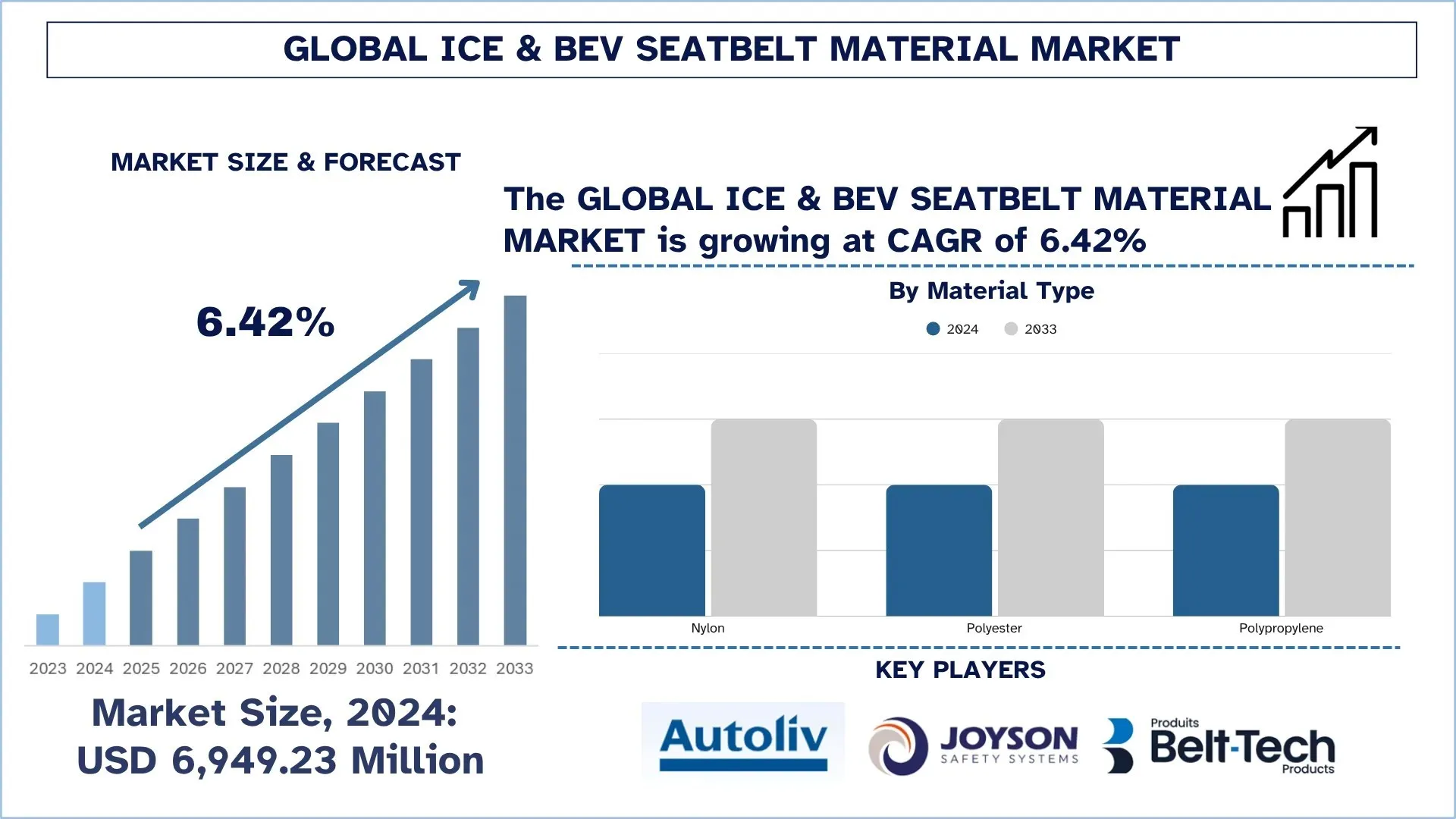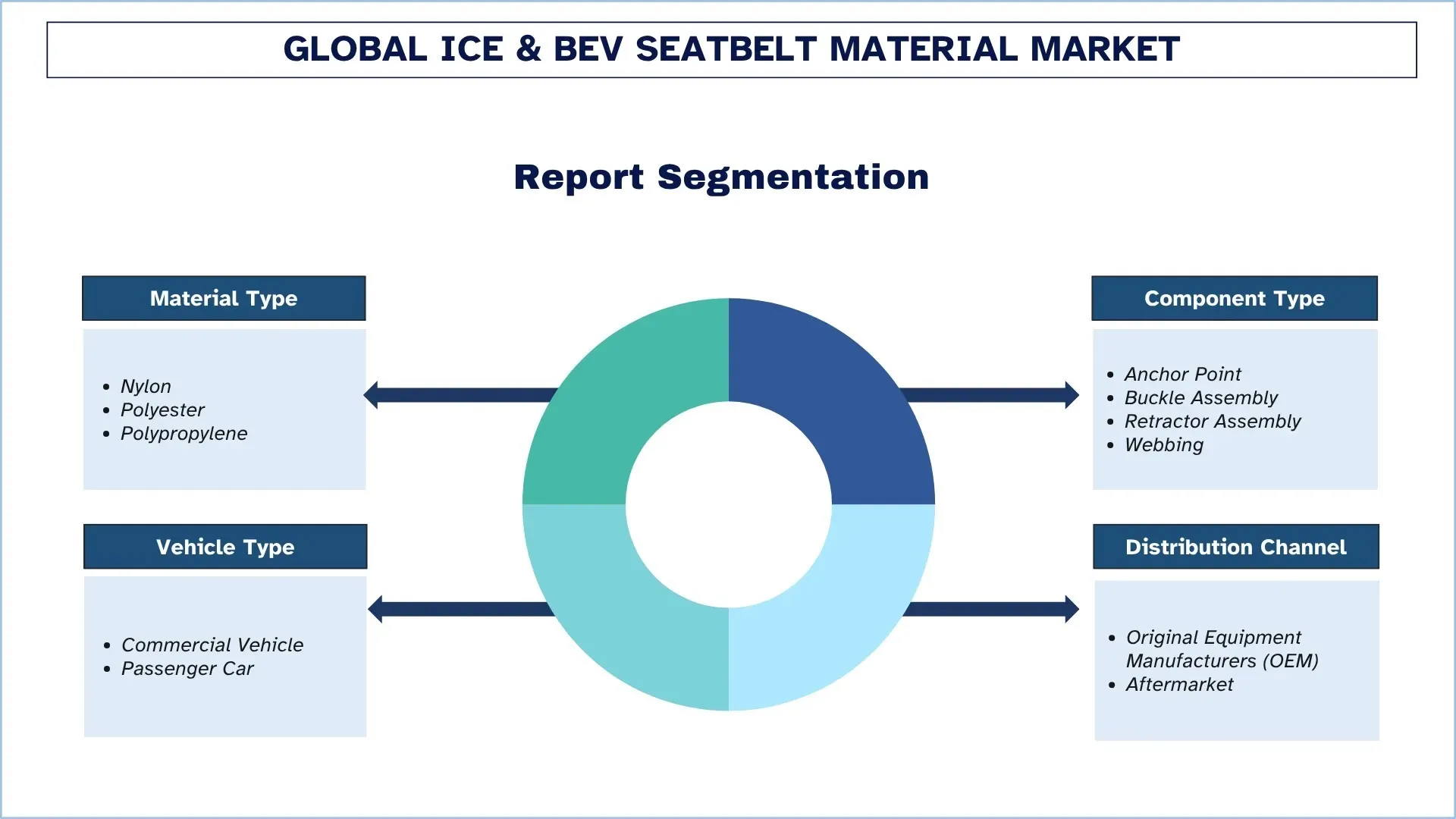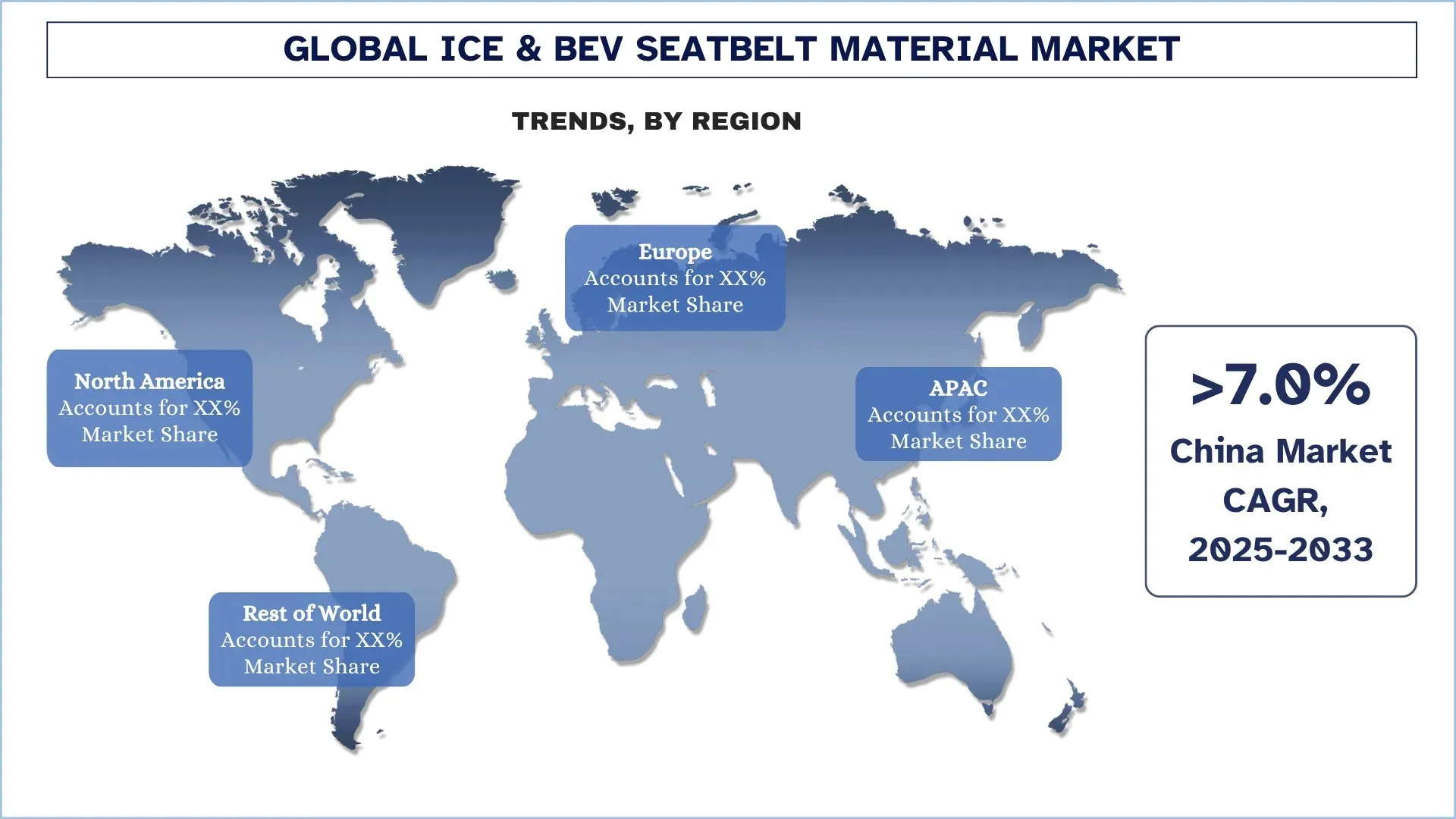- Home
- About Us
- Industry
- Services
- Reading
- Contact Us
ICE & BEV Seatbelt Material Market: Current Analysis and Forecast (2025-2033)
Emphasis on Material Type (Nylon, Polyester, and Polypropylene); Component Type (Anchor Point, Buckle Assembly, Retractor Assembly, and Webbing); Vehicle Type (Commercial Vehicle and Passenger Car); Distribution Channel (Original Equipment Manufacturers (OEM) and Aftermarket); and Region/Country

Global ICE & BEV Seatbelt Material Market Size & Forecast
The Global ICE & BEV Seatbelt Material Market was valued at USD 6949.23 million in 2024 and is expected to grow at a strong CAGR of around 6.42% during the forecast period (2025-2033F), driven by the rising vehicle production & electrification and stringent safety regulations.
ICE & BEV Seatbelt Material Market Analysis
The ICE & BEV Seatbelt Material Market is a specialized fabric and webbing type that is engineered to be safe, durable, and comfortable to be used both in Internal Combustion Engine (ICE) and in the Battery Electric Vehicle (BEV) market. The materials used to make seatbelts are designed to provide high tensile performance, abrasion resistance, and resistance to flame, as well as passenger safety during crash and impact events. The products available in the market are a diverse range of products, such as polyester webbing, nylon seatbelt fabrics, aramid reinforced products, and bio-based materials that are environmentally friendly to enable them to meet the safety requirements of the automotive industry. Also, market demand is being driven by the increased attention to compliance with safety, crashworthiness, and higher-order restraint systems of passenger and commercial vehicles. In addition, the current trend in adopting modern, efficient, and environmentally sustainable safety solutions is being influenced by the growing interplay between lightweight, sustainable, and recyclable seatbelt materials on both ICE and BEV platforms.
Global ICE & BEV Seatbelt Material Market Trends
This section discusses the key market trends that are influencing the various segments of the global ICE & BEV seatbelt material market, as found by our team of research experts.
Adoption of Smart and Sensor-Integrated Seatbelts
The adoption of smart and sensor-integrated seatbelts is one of the most promising upcoming trends in the ICE and BEV seatbelt material market. These systems may be able to detect real-time belt tension, occupancy, usage, and exchange information with vehicle safety systems to adjust dynamically in case of a crash event. As an example, in June 2025, Volvo will have an example when it has a "multi-adaptive safety belt" on its future EX60 EV, which will be able to identify 11 load-limiting profiles using sensor data (body shape, seating position, crash metrics) and choose the best one to secure the maximum protection.
Another one: Active Control Retractor (ACR), technology by ZF, vibrates or pre-tensions the belt according to the dynamics of the vehicle to improve occupant warning and control. The stricter safety regulations, increasing consumer demands on so-called connected safety, and the trend of integrated, intelligent vehicle architectures are the driving forces behind this trend. Seatbelt systems are no longer simple mechanical boxes, but adaptive, active safety systems that are becoming more sensor-laden and computer-controlled as vehicles rely less on mechanical engineering and more on software engineering.
ICE & BEV Seatbelt Material Industry Segmentation
This section provides an analysis of the key trends in each segment of the global ICE & BEV seatbelt material market report, along with forecasts at the global, regional, and country levels for 2025-2033.
The Polyester Segment Dominates the Global ICE & BEV Seatbelt Material Market
Based on the material type, the global ICE & BEV Seatbelt Material Market is segmented into nylon, polyester, and polypropylene. Among these, the polyester segment dominated the market and is expected to dominate in the forecast period. This is attributed to its high tensile strength, high abrasion resistance, low stretch under load, and also good UV and heat resistance, making it the most popular material in the manufacture of seatbelts. Polyester webbing is extremely popular with automotive OEMs in both ICE and BEV applications as it provides a balance of durability, safety, and cost-effectiveness. Its consistency in providing safety to passengers in situations involving crashes and adherence to high standards of international safety have made polyester the preferred choice when it comes to the production of seatbelts. The nylon segment, though relatively smaller, is likely to enjoy gradual adoption, owing to its large impact resistance, flexibility, and soft feel, which offers greater comfort to the passengers.
The Retractor Assembly Segment Dominates the Global ICE & BEV Seatbelt Material Market.
Based on the component type, the global ICE & BEV Seatbelt Material Market is categorized into anchor point, buckle assembly, retractor assembly, and webbing. The retractor assembly segment dominated the market, as it forms the core feature of a seatbelt system, which influences automatic adjustment, tension control, and ensures a security level in locking during sudden deceleration or collisions. A more sophisticated feature that is being added to retractor assemblies is emergency locking retractors (ELR), pre-tensioners, and load limiters, which have substantially increased the safety and comfort of passengers. The increasing use of electronic sensors and smart-safety technologies, particularly in BEVs where high-level occupant protection is a major differentiator, is creating demand for innovative and intelligent retractor systems. This high usage in both ICE and BEV vehicles makes retractor assemblies the most popular type of component in the marketplace.

Asia Pacific holds the largest market share in the Global ICE & BEV Seatbelt Material market
The Asia Pacific region is the largest in the world in the automotive seatbelt material, with the high volume of vehicle production, fast urbanization, and growing disposable income that have greatly boosted the number of vehicles per household in the various countries, such as China, India, and Japan. China had the highest market share in the world in the year 2024, and the nation was projected to produce nearly 33.8 percent of the global vehicle production. It is a market leader in the internal combustion engine (ICE) and electric vehicle (EV) sectors. The high demand for compact SUVs in the Asia Pacific markets is led by OEMs like Hyundai, Tata Motors, Toyota, Maruti Suzuki, Mahindra and Mahindra, MG Motors, and other local manufacturers, with many of the new models including captain seats in the middle rows, each fitted with individual seatbelt retractors to protect the occupants better. Whereas economy models, especially ICE, offer front captain seat retractors or rear bench seat retractors, the increasing popularity of premium vehicles in the Asia Pacific market has led to the introduction of retractors in the rear and even third-row seats to ensure a high level of safety requirements.
China held a Dominant share of the Asia Pacific ICE & BEV Seatbelt Material Market in 2024
China was the leading manufacturer of the ICE and BEV seatbelt material in the Asia Pacific. This is because it is the largest car manufacturer in the world, and it is backed by the highest producing automakers like BYD, SAIC Motor, and Geely that spur tremendous demand for high-performance seatbelt materials. The intensive interest of the country in electrifying vehicles, supported by governmental incentives and policies that encourage new energy vehicles (NEVs), also accelerates the process of implementing lightweight, recyclable, and more advanced fabrics in the seatbelts of BEVs. Moreover, China is enjoying a strong ecosystem of manufacturing, availability of raw materials, and a high rate of development in the field of textile engineering and manufacturing of safety components that have further enhanced its competitiveness in the international market. The ongoing investments in research and development and the partnership with other suppliers of safety systems worldwide improve the progress of smart and sensor-based seat-belt technologies that meet the increased safety standards. High-scale vehicle production, high BEV penetration, and emphasis on sustainable materials have placed China in a lead and rapidly expanding role in the international ICE and BEV seatbelt material market.

ICE & BEV Seatbelt Material Industry Competitive Landscape
The global ICE & BEV seatbelt material market is competitive, with several global and international market players. The key players are adopting different growth strategies to enhance their market presence, such as partnerships, agreements, collaborations, geographical expansions, and mergers and acquisitions.
Top ICE & BEV Seatbelt Material Market Companies
Some of the major players in the market are Autoliv, Joyson Safety Systems, Belt-tech, Bxseatbelts, Coats Group plc, Country Brook Design, Daicel Corporation, Berger GmbH & Co. Holding KG, GOOD SUCCESS CORP., and GWR Safety Systems.
Recent Developments in the ICE & BEV Seatbelt Material Market
In December 2024, ZF LIFETEC's electro-locking system, an electromechanical upgrade to traditional seatbelt locking mechanisms, replaced the steel ball sensor with an electromagnetic coil controlled by a central ECU. It enhances safety via pre-crash triggering (synced with ADAS) and improves comfort by reducing unwanted locking on rough roads.
In September 2024, Holmbergs filed for insolvency for its Romanian subsidiary company, Te-Rox Prod, which was acquired in early 2020 to produce child car seat components and seatbelts. The insolvency was filed due to increasing energy/labor costs and Europe’s regulatory challenges for the expensive recertifications.
Global ICE & BEV Seatbelt Material Market Report Coverage
Report Attribute | Details |
Base year | 2024 |
Forecast period | 2025-2033 |
Growth momentum | Accelerate at a CAGR of 6.42% |
Market size 2024 | USD 6,949.23 million |
Regional analysis | North America, Europe, APAC, Rest of the World |
Major contributing region | Asia Pacific region is expected to dominate the market during the forecast period. |
Key countries covered | U.S., Canada, Germany, U.K., Spain, Italy, France, China, Japan, South Korea, and India. |
Companies profiled | Autoliv, Joyson Safety Systems, Belt-tech, Bxseatbelts, Coats Group plc, Country Brook Design, Daicel Corporation, Berger GmbH & Co. Holding KG, GOOD SUCCESS CORP., and GWR Safety Systems |
Report Scope | Market Trends, Drivers, and Restraints; Revenue Estimation and Forecast; Segmentation Analysis; Demand and Supply Side Analysis; Competitive Landscape; Company Profiling |
Segments Covered | By Material Type, By Component Type, By Vehicle Type, By Distribution Channel, and By Region/Country |
Reasons to Buy the ICE & BEV Seatbelt Material Market Report:
The study includes market sizing and forecasting analysis confirmed by authenticated key industry experts.
The report briefly reviews overall industry performance at a glance.
The report covers an in-depth analysis of prominent industry peers, primarily focusing on key business financials, type portfolios, expansion strategies, and recent developments.
Detailed examination of drivers, restraints, key trends, and opportunities prevailing in the industry.
The study comprehensively covers the market across different segments.
Deep dive regional level analysis of the industry.
Customization Options:
The global ICE & BEV seatbelt material market can further be customized as per the requirements or any other market segment. Besides this, UnivDatos understands that you may have your own business needs; hence, feel free to contact us to get a report that completely suits your requirements.
Table of Content
Research Methodology for the Global ICE & BEV Seatbelt Material Market Analysis (2023-2033)
We analyzed the historical market, estimated the current market, and forecasted the future market of the global ICE & BEV seatbelt material market to assess its application in major regions worldwide. We conducted exhaustive secondary research to gather historical market data and estimate the current market size. To validate these insights, we carefully reviewed numerous findings and assumptions. Additionally, we conducted in-depth primary interviews with industry experts across the ICE & BEV seatbelt material value chain. After validating market figures through these interviews, we used both top-down and bottom-up approaches to forecast the overall market size. We then employed market breakdown and data triangulation methods to estimate and analyze the market size of industry segments and sub-segments.
Market Engineering
We employed the data triangulation technique to finalize the overall market estimation and derive precise statistical numbers for each segment and sub-segment of the global ICE & BEV seatbelt material market. We split the data into several segments and sub-segments by analyzing various parameters and trends, including material type, component type, vehicle type, distribution channel, and regions within the global ICE & BEV seatbelt material market.
The Main Objective of the Global ICE & BEV Seatbelt Material Market Study
The study identifies current and future trends in the global ICE & BEV seatbelt material market, providing strategic insights for investors. It highlights regional market attractiveness, enabling industry participants to tap into untapped markets and gain a first-mover advantage. Other quantitative goals of the studies include:
Market Size Analysis: Assess the current and forecast market size of the global ICE & BEV seatbelt material market and its segments in terms of value (USD).
ICE & BEV Seatbelt Material Market Segmentation: Segments in the study include areas of material type, component type, vehicle type, distribution channel, and region.
Regulatory Framework & Value Chain Analysis: Examine the regulatory framework, value chain, customer behavior, and competitive landscape of the ICE & BEV seatbelt material industry.
Regional Analysis: Conduct a detailed regional analysis for key areas such as Asia Pacific, Europe, North America, and the Rest of the World.
Company Profiles & Growth Strategies: Company profiles of the ICE & BEV seatbelt material market and the growth strategies adopted by the market players to sustain the fast-growing market.
Frequently Asked Questions FAQs
Q1: What is the global ICE & BEV seatbelt material market’s current market size and growth potential?
As of 2024, the global ICE & BEV seatbelt material market is valued at USD 6949.23 million and is projected to grow at an impressive CAGR of 6.42% from 2025 to 2033. This growth is driven by the rising vehicle production & electrification and stringent safety regulations.
Q2: Which segment has the largest share of the global ICE & BEV seatbelt material market by material type category?
The polyester segment dominated the market and is expected to dominate in the forecast period. This is attributed to its high tensile strength, high abrasion resistance, low stretch under load, and also good UV and heat resistance, making it the most popular material in the manufacture of seatbelts.
Q3: What are the driving factors for the growth of the global ICE & BEV seatbelt material market?
Top growth drivers of the ICE & BEV seatbelt material market include:
• Rising Vehicle Production & Electrification: Growing global vehicle manufacturing, including the rapid adoption of electric vehicles (EVs), increases demand for advanced seatbelt materials that ensure safety, energy efficiency, and compatibility with modern vehicle architectures.
• Stringent Safety Regulations: Tighter global automotive safety standards and crash-test requirements drive automakers to use high-performance, certified seatbelt materials that enhance occupant protection and meet evolving regulatory compliance.
• Focus on Lightweighting & Sustainability: The industry’s shift toward lightweight, eco-friendly materials promotes seatbelt innovations using recycled fibers, bio-based polymers, and advanced weaves to reduce vehicle weight and environmental impact without compromising safety.
Q4: What are the emerging technologies and trends in the global ICE & BEV seatbelt material market?
Emerging trends in the ICE & BEV seatbelt material market include:
• Adoption of Smart & Sensor-Integrated Seatbelts: Automakers are integrating sensors and electronic systems into seatbelts to monitor occupant status, tension, and position, enabling adaptive restraint systems that enhance safety, data analytics, and connectivity in modern vehicles.
• Customization & Comfort-Oriented Designs: Manufacturers focus on ergonomically designed, adjustable, and aesthetically appealing seatbelts using softer, flexible, and premium materials to improve passenger comfort, personalization, and overall in-cabin experience.
Q5: What are the key challenges in the global ICE & BEV seatbelt material market?
Key challenges in the ICE & BEV seatbelt material market include:
• High Cost of Advanced Materials: The development and use of high-performance, lightweight, and sustainable seatbelt materials such as aramid fibers or bio-based polymers significantly increase production costs, limiting affordability and widespread adoption, especially in cost-sensitive markets.
• Raw Material Supply Fluctuations: Volatility in the availability and pricing of key raw materials like nylon, polyester, and specialty fibers disrupts manufacturing stability, affecting production timelines, profitability, and supply chain reliability for seatbelt material producers.
Q6: Which region dominates the global ICE & BEV seatbelt material market?
Asia Pacific dominates the global ICE & BEV seatbelt material market. This is due to rapid automotive production growth, increasing vehicle electrification, expanding manufacturing capabilities, and rising safety awareness, driving demand for advanced, cost-efficient seatbelt materials.
Q7: Who are the key competitors in the global ICE & BEV seatbelt material market?
Top players in ICE & BEV seatbelt material industry include:
• Autoliv
• Joyson Safety Systems
• Belt-tech
• Bxseatbelts
• Coats Group plc
• Country Brook Design
• Daicel Corporation
• Berger GmbH & Co. Holding KG
• GOOD SUCCESS CORP.
• GWR Safety Systems
Q8: How is automation transforming the ICE & BEV seatbelt material industry?
Automation is revolutionizing the ICE & BEV seatbelt material market by streamlining weaving, coating, and testing processes. Advanced robotic systems, AI-based quality inspection, and automated tension-control technologies enhance precision, reduce waste, lower labor costs, and boost overall production efficiency and consistency.
Q9: What investment opportunities exist in the ICE & BEV seatbelt material market?
Investment opportunities are strong in sustainable fiber production, smart sensor-integrated seatbelt technologies, and automated material processing systems. With increasing EV production and strict safety standards, investors can benefit from supporting companies developing innovative, lightweight, and eco-friendly seatbelt material solutions.
Related Reports
Customers who bought this item also bought










